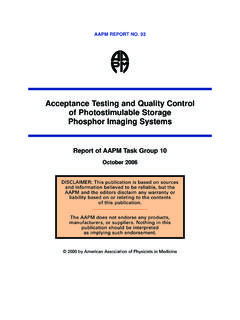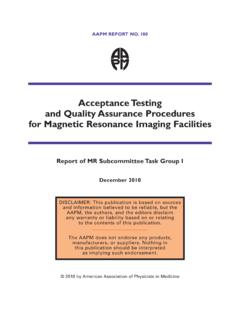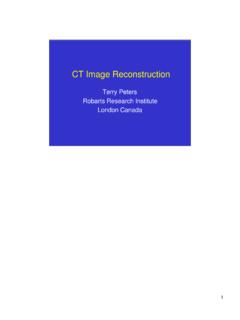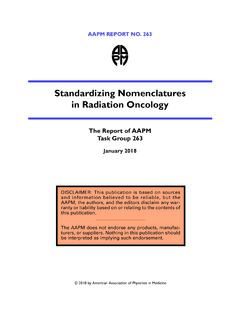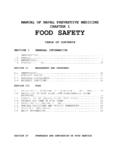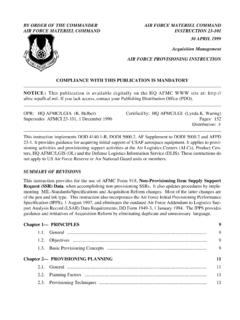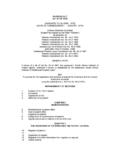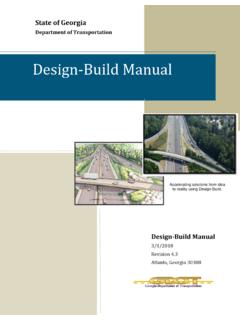Transcription of Acceptance Testing and Quality Control of Dental …
1 AAPM REPORT NO. 175 Acceptance Testing and Quality Control of Dental Imaging EquipmentThe Report of AAPMTask Group 175 September 2016 DISCLAIMER: This publication is based on sourcesand information believed to be reliable, but theAAPM, the authors, and the editors disclaim any war-ranty or liability based on or relating to the contents ofthis AAPM does not endorse any products, manufac-turers, or suppliers. Nothing in this publication shouldbe interpreted as implying such endorsement. 2016 by American Association of Physicists in MedicineThis page intentionally left of Alberta, Edmonton, Alberta2 Memorial Sloan Kettering Cancer Center, New York, New York3 Mayo Clinic College of Medicine, Emeritus Staff, Rochester, Minnesota and DIQUAD, LLC, Steger, Illinois4 Medical X-Ray Center, , Sioux Falls, South Dakota5 University of Texas Health Science Center, San Antonio, Texas, Retired6 The University of North Carolina, Chapel Hill, North Carolina7 Weill Cornell Medical College, New York, New York, Retired8 University of California, Davis, Sacramento, California9 University of California, Los Angeles, Los Angeles, CaliforniaAcceptance Testing and Quality Controlof Dental Imaging EquipmentThe Report of AAPM Task Group 175 Alexander L.
2 C. Kwan1 (Chair), Hung Ching2 (Co-chair), Joel E. Gray3, Richard J. Massoth4, W. Doss McDavid5, Enrique Platin6,Leonard M. Rosenstein7, J. Anthony Seibert8, and Stuart C. White9 DISCLAIMER: This publication is based on sources and information believed to be reliable, but the AAPM, the authors, and the publisher disclaim any warranty or liabilitybased on or relating to the contents of this AAPM does not endorse any products, manufacturers, or suppliers. Nothing in this publication should be interpreted as implying such : 978-1-936366-56-9 ISSN: 0271-7344 2016 by American Association of Physicists in MedicineAll rights reservedPublished byAmerican Association of Physicists in Medicine1631 Prince StreetAlexandria, VA 22314-2818 THE REPORT OF AAPM TASK GROUP 175: Acceptance Testing and Quality Control of Dental Imaging Equipment5 Contents1. Introduction .. 72.
3 Image Receptor Recommendations for Intraoral Dental Units .. 73. Acceptance Testing and Quality Control (QC) Recommendations for Intraoral Dental Units .. Head Stability and Positioning (Not Applicable to Handheld Units) .. Leakage Radiation and Visual Inspection .. and Minimum Source-to-Skin Distance .. Beam Quality .. (kVp) Accuracy .. Accuracy.. Reproducibility .. (mA) or Milliampere-second (mAs) Linearity .. Quality Control (If X-ray Film Is Used) .. Film Processing Quality Control for Intraoral Film .. Quality Control for Digital Intraoral Image Receptors .. Evaluation of Site s Quality Control Program .. Technique Factors and Entrance Skin Air Kerma.. Scattered Radiation Survey .. 144. Acceptance Testing and Quality Control Recommendations for Panoramic Dental Units .. Leakage Radiation and Visual Inspection.
4 Beam Slit Length and Width Coincidence .. Quality .. Accuracy .. Reproducibility .. Quality Control (If X-ray Film Is Used) .. Control for Digital Panoramic Image Receptors .. Factors .. of Site s Quality Control Program .. Scattered Radiation Survey .. Testing and Quality Control Recommendations for Cephalometric Dental Units .. Leakage Radiation and Visual Inspection .. Exposure Reproducibility, Typical Entrance Air Kerma, and Technique Factors .. Quality .. Accuracy .. (mA) or Milliampere-second (mAs) Linearity (if applicable) .. Accuracy (If Applicable) .. Quality Control (If X-ray Film Is Used) .. Control for Digital Cephalometric Image Receptors .. Evaluation of Site s Quality Control Program .. Scattered Radiation Survey .. 26 References .. 29 THE REPORT OF AAPM TASK GROUP 175: Acceptance Testing and Quality Control of Dental Imaging Equipment6 AbstractThe purpose of Task Group 175 (TG-175) is to investigate the factors that affect image Quality anddose in Dental units.
5 Described herein are the recommendations for specific parameter evaluations andpractical procedures that may be conducted by medical physicists on the x-ray systems associatedwith Dental facilities. This report is structured so that each section may be viewed as an independent chapter for the dif-ferent Dental modalities. Section 2 of this report provides image receptor recommendations for intra-oral Dental units. Sections 3, 4, and 5 provide information for the evaluation of intraoral, panoramic,and cephalometric Dental units, respectively. Evaluation of cone-beam CT Dental units is not includedin this task group report. The intent of this report is to provide useful information and guidance for performing acceptancetesting and Quality Control of Dental imaging REPORT OF AAPM TASK GROUP 175: Acceptance Testing and Quality Control of Dental Imaging Equipment71.
6 IntroductionIt is important to properly perform tests for image Quality and safety purposes right after the instal-lation and during routine operation of a Dental x-ray unit. Having a Quality Control (QC) program fordental x-ray facilities is instrumental in ensuring that patients are not receiving excessive radiationduring their examination. A QC program also ensures that the Dental x-ray imaging equipment isworking properly, as exemplified by scientific and technical Testing to confirm that the machine is per-forming as per manufacturer s specification and regulatory requirements. Recommendations for specific parameter evaluations and practical procedures for Quality controlevaluations of Dental imaging equipment are described in this document. Section 2 of this report pro-vides image receptor recommendations for intraoral Dental units.
7 Sections 3, 4, and 5 provide informa-tion for the evaluation of intraoral, panoramic, and cephalometric Dental units, respectively. Inaddition, all methods mentioned in this report are intended to provide guidance on how to performthese medical physics tests, but they are not intended to be the sole methods for performing any partic-ular cone-beam CT (CBCT) has become common in the offices of many Dental specialists, thismodality falls outside the scope of this task group report. Another AAPM task group (TG-261) will beaddressing CBCT for Dental and maxillofacial imaging, and their report should be forthcoming. 2. Image Receptor Recommendations for Intraoral Dental UnitsCurrently, there are three types of receptor technologies available for intraoral imaging:1. film (including D-, E-, E/F- and F-speed), 2. photostimulable storage phosphor (PSP) receptors, and3.
8 Charge-coupled devices (CCD) and complementary metal oxide semiconductor (CMOS) discussion of the difference in the technology of the digital receptors, and information on digitalradiography in general, can be found in references 1 3. There is approximately a factor of two differ-ence in the speed, or sensitivity, of D-speed compared with E-, E/F-, or F-speed films; as a result, theE-, E/F-, or F-speed film requires only approximately half of the radiation of the D-speed film for thesame image 8 Because of potential reduction in radiation without significant loss in image Quality , TG-175 recommends the exclusive use of E-, E/F-, or F-speed film. D-speed film should not be recommendation is in agreement with the recommendations from the National Council onRadiation Protection and Measurements (NCRP).9 as well as the American Dental Association andthe Food and Drug In addition, NCRP has recently recommended a diagnosticreference level (DRL)* of mGy (entrance skin air kerma) for all Dental intraoral imaging regardlessof film speed or type of image With D-speed film, this is insufficient to produce properlyexposed Dental imaging using PSP or CCD/CMOS technology offers radiation dose reductions to dentalpatients and staff while providing similar or improved image 14 PSP receptors require aradiation dose similar to E-, E/F-, or F-speed films, while CMOS receptors require 50% to 80% of the* A diagnostic reference level (DRL) represents an exposure at approximately the 75th percentile level of the distribution of survey exposures.
9 If a facility uses exposures above the DRL, actions should be taken to optimize image Quality with exposures below this REPORT OF AAPM TASK GROUP 175: Acceptance Testing and Quality Control of Dental Imaging Equipment8dose required for F-speed film, depending on the type of CMOS Lastly, CCD receptorstypically require less than half the radiation of F-speed , TG-175 recommends the use of one of the following:1) E-, E/F-, or F-speed radiographic film,2) PSP receptors, or3) CCD/CMOS Acceptance Testing and Quality Control (QC) Recommendationsfor Intraoral Dental UnitsRecommended tests for Acceptance Testing and Quality Control of intraoral Dental units are listedbelow. In addition, local and state regulation requirements should be reviewed to ensure all requiredtests are performed and their limits are met. These evaluations, with the exception of those in and , should be performed or supervised by a QMP16 before the unit is used clinically andannually thereafter.
10 The QMP, who at the minimum should co-sign the final report, is ultimatelyresponsible for all of the content. In all cases, the test results must meet the manufacturer s specifica-tions. For older units only, where such manufacturer specifications may not be available, the standardsgiven below should be handheld units are in use in the offices of general dentists and various Dental QMP may want to confirm if there are any additional requirements in state and local regulations(such as scattered radiation protection, radiation monitoring requirements, and secure storage of the x-ray unit). Tube Head Stability and Positioning (not applicable to handheld units)Tube head drift or oscillation should stop within 1 second after the operator releases the tube head,and any drift shall be no greater than cm, according to the Tube head drift should bechecked to ensure Leakage Radiation and Visual InspectionVisual inspection of the tube housing should be made to ensure the radiation shielding is not dam-aged.

